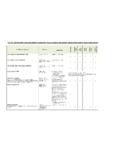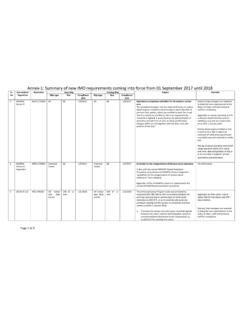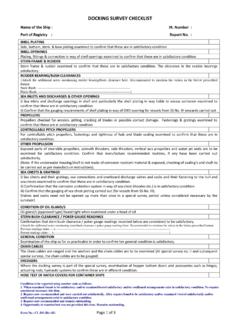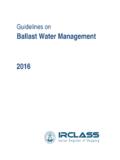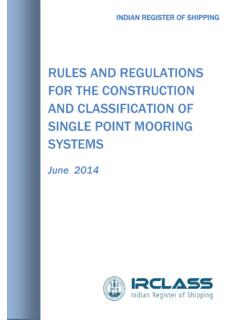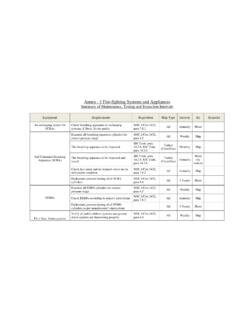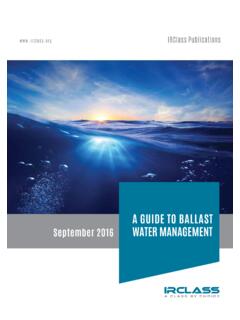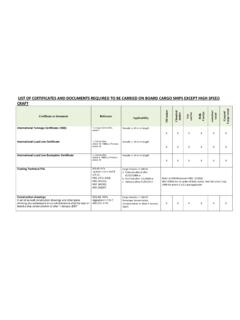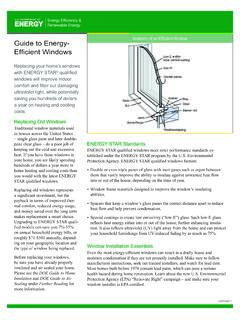Transcription of Implementing Energy Efficiency Design Index (EEDI)
1 Implementing Energy Efficiency Design Index (EEDI). What is EEDI? Energy Efficiency Design Index (EEDI), formulated for new ships, is an Index that estimates grams of CO2 per transport work (g of CO2 per tonne mile). It can be expressed as the ratio of environmental cost divided by Benefit for Society . Impact to environment EEDI = ------------------------------------ Benefit for society CO2 Emission EEDI = ------------------------------------ In other words, Transport Work It is a function of Installed power Speed of vessel Cargo carried The philosophy behind EEDI is that its computation be simple and capable of broad application, and promote efforts by all stakeholders to reduce CO2 emissions by reflecting a ship's Energy Efficiency in actual use.
2 It stimulates continued technical development of all the components influencing the fuel Efficiency of a ship. It also separates the technical and Design based measures from the operational and commercial ones. The document aims at updating the industry on matters related to EEDI and its application and impact. EEDI Genesis The GHG study conducted by IMO in 2000 resulted into an operational CO2 Index . It was accepted at IMO that such an Index should reflect only the technical aspects such as the optimization of engines, hull and propeller or the use of non fossil fuels, and not the operational or commercial aspects. This led to the refinement of the Index . After much deliberation in its Marine Environmental Protection Committee's various sessions, the current empirical formulation was accepted.
3 The formulations, which were recommended at different stages, are given below. FC * C i carbon AFC * Power * * CO Index i I . m * D. 2. c arg o ,i i DWT * Speed i M nME P C SFC P P C SFC . nPTI nWHR neff f j CFMEiSFCMEiPMEi AE FAE AE PTIi WHRi FAE AE f eff Peff CFeff SFCMEi . i 1 . j 1 i 1 i 1 i 1 . f i Capacity V ref f W. EEDI is applicable to new ships. It is intended to ensure that new ships are designed to be Energy efficient. It cannot be used as a performance indicator of the operational Energy Efficiency of the existing fleet of vessels. EEDI Formula Parameters explained Parameter Description Source CF Non dimensional conversion factor MEPC 245(66) 2014 Guidelines on the between fuel consumption and CO2 calculation of the Attained EEDI for new emission ships.
4 Vref Ship speed in nautical miles per hour At Design Stage Speed power curves obtained from model testing At final Stage Sea Trial Report Capacity Computed as a function of Deadweight Stability Booklet as indicated in and of MEPC. 245(66) 2014 Guidelines on the calculation of the Attained EEDI for new ships . PME 75% of the main engine MCR in kW NOx Technical File PAE Auxiliary Engine Power MEPC 245(66) 2014 Guidelines on the PPTI 75% of rated power consumption of calculation of the Attained EEDI for new shaft motor ships . Peff Output of innovative mechanical Energy efficient technology for propulsion at 75% main engine power PAEeff Auxiliary power reduction due to innovative electrical Energy efficient technology SFC Certified Specific Fuel Consumption in NOx Technical file g/kWh fj Correction factor to account for ship MEPC 245(66) 2014 Guidelines on the specific Design elements.
5 (For ice calculation of the Attained EEDI for new classed ships, shuttle tankers) ships . fw Non dimensional coefficient indicating the decrease of speed in representative sea condition of wave height, wave frequency and wind speed fi Capacity factor for any technical /. regulatory limitation on capacity fc Cubic capacity correction factor (for chemical tankers and gas carriers). fl Factor for general cargo ships equipped with cranes and other cargo . related gear to compensate in a loss of deadweight of the ship feff Availability factor of innovative Energy Efficiency technology The EEDI expresses the impact to environment Impact to environment Power*SFC* FC. EEDI = ---------------------------------- = ---------------------------- from shipping Vs the Benefit to society Deadweight *speed benefit to society from shipping.
6 The EEDI formula takes into consideration special Design features and needs, including the use of Energy recovery, the use of low carbon fuels, performance of ships in waves and the need for ice strengthening of certain ships. The handling of certain Design features such as electric propulsion is still subject to evaluation. The EEDI has a constant value that will only be changed if the Design is altered. There are some ship types where the EEDI, in units per nautical mile, may be considered less meaningful or relevant. This, and the possible need for a minimum size threshold, suggests that the units in which EEDI is measured may need modification to address some ship types and ship sizes, and that the EEDI may not be practically applicable to all ship types.
7 However, large cargo ships can be covered and these ships account for a significant share of emissions. EEDI Baseline A reference line (baseline) is defined as a curve representing an average Index value fitted on a set of individual Index values for a defined group of ships.. Reference line = a (Capacity) -c Where, a and c are constants determined from the regression curve fit. How EEDI is applied? For each new ship the attained EEDI shall be as follows: X . 1 =. Attained EEDI Required EEDI * Baseline 100 . Reduction rate X would be determined according to year of built for new ships in phases How to improve EEDI? Technologies Hulls with less resistance and improved steering configurations.
8 More efficient aft-ship, propeller and rudder arrangements. Lower Energy consumption in main and auxiliary engines. Switch from oil to natural gas as main fuel. Miscellaneous technologies to reduce minor Energy consumers (deck paint, pipe insulation, lighting, air conditioning, etc.). Zero or minimum ballast configurations ( , by alternative Design or ship type). Marine fuel cells (longer term); and Hybrid ships ( , wind power, solar panels, and use of light materials, etc.) (longer term). Applicable Ship Types and Reduction Factors (in %). Phase 0 Phase 1 Phase 2 Phase 3. Ship Type Size 1 Jan 2013 1 Jan 2015 1 Jan 2020 1 Jan 2025. 31 Dec 2014 31 Dec 2019 31 Dec 2024 and onwards 20,000 DWT.
9 0 10 20 30. and above Bulk Carrier 10,000 . n/a 0 10* 0 20* 0 30*. 20,000 DWT. 10,000 DWT. 0 10 20 30. and above Gas Carrier 2,000 . n/a 0 10* 0 20* 0 30*. 10,000 DWT. 20,000 DWT. 0 10 20 30. and above Tanker 4,000 . n/a 0 10* 0 20* 0 30*. 20,000 DWT. 15,000 DWT. 0 10 20 30. Container and above Ship 10,000 . n/a 0 10* 0 20* 0 30*. 15,000 DWT. 15,000 DWT. 0 10 15 30. General and above Cargo Ship 3,000 . n/a 0 10* 0 15* 0 30*. 15,000 DWT. 5,000 DWT. 0 10 15 30. Refrigerated and above Cargo Carrier 3,000 5,000. n/a 0 10* 0 15* 0 30*. DWT. 20,000 DWT. 0 10 20 30. Combination and above Carrier 4,000 . n/a 0 10* 0 20* 0 30*. 20,000 DWT. LNG Carrier 10,000 DWT. n/a 10** 20 30.
10 ** and above Ro ro cargo 10,000 DWT. ship (vehicle n/a 5** 15 30. and above carrier)**. 2,000 DWT. n/a 5** 20 30. Ro ro cargo and above ship** 1,000 . n/a 0 5* ** 0 20* 0 30*. 2,000 DWT. 4,000 GT and Ro ro n/a 5** 20 30. above passenger 1,000 . ship** n/a 0 5* ** 0 20* 0 30*. 4,000 GT. Cruise passenger 85,000 GT. n/a 5 ** 20 30. ship** and above having non 25,000 . conventional n/a 0 5* ** 0 20* 0 30*. 85,000 GT. propulsion * Reduction factor to be linearly interpolated between the two values depending upon vessel size. The lower value of the reduction factor is to be applied to the smaller size. ** Phase 1 commences for those ships on 1st September 2015. ** Reduction rate applies those ships delivered on or after 1st September 2019.
